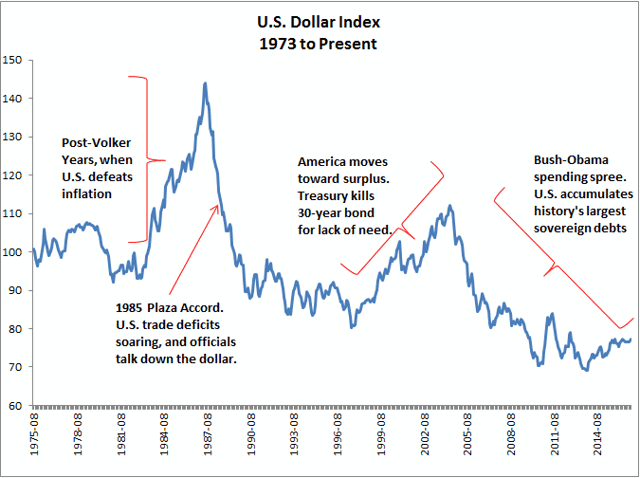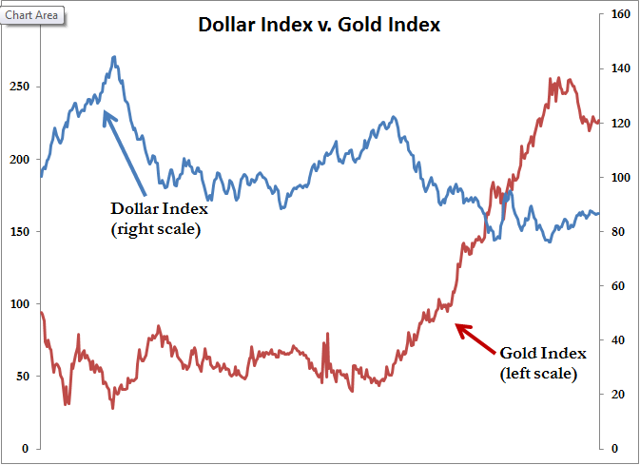Why Gold Will Rise When The Dollar Falls
Aug. 12, 2014 5:54 PM ET
by: Jeff Opdyke
- Gold is not dead. Buy it now, while it's cheap.
- When America's finances are weak, the dollar is almost worthless.
- The dollar is deeply flawed by the government.
Agnico Eagle Mines (NYSE:AEM), Yamana Gold (NYSE:AUY) and other miners are snapping gold assets that larger players are casting off. So far this year, small- and mid-sized gold miners have spent $14 billion grabbing mining assets, the highest total in three years.
What makes this interesting to me - a fan of gold in the form of bullion, collectible coins and mining shares - is the message it sends: Gold is cheap… so grab some today.
Corporate executives, particularly in the hard-commodity space, regularly use price weakness to their advantage. When prices tumble to levels that are irrationally cheap, they regularly step up to the plate, open up the corporate pocketbook and buy these assets while they're on sale.
That's what we're seeing today.
And it's a message that gold is not the dead asset class that too many in the media portray it as.
It is, however, cheap relative to America's underlying financial fundamentals - and today, that's the only reason you need to maintain a permanent position in gold. I use these two charts below all the time because they pretty much tell you all you need to know about the dollar and gold's relationship to it. And what they tell you is that gold is the antidote to the financial incompetence endemic in Washington, D.C.
Chart 1 shows nearly 40 years of the U.S. Dollar Index, as reported by the U.S. Treasury Department. I have annotated it with commentary to explain the decisive rises and falls that happened. The takeaway: When America is clearly working to improve its finances, the U.S. dollar rallies strongly. When America's finances are going to hell - or are already there, as they are today - the dollar becomes little more than artistic toilet paper.
(click to enlarge)

Chart 2 plots the direction of gold relative to the Dollar Index. The take away here is that gold moves almost diametrical to the dollar. As the dollar tanks, gold rises. As the dollar rises, gold tanks.
(click to enlarge)

What we have, then, is the biggest, fundamental question in financial markets today: Where is the dollar ultimately going? Answer that, and you have the long-term direction for gold.
I am pretty confident I know the direction of the dollar, as Chart 1 so plainly indicates.
We all know that the financial situation in America today is the worst that it has ever been. I'm not talking about the economy or the jobs market or housing - all of which are, themselves, questionable, too. No, I'm talking about our country's underlying finances.
If the American government were the typical American family, the country would be well past the point of bankruptcy. America's annual income - the tax revenue and fees it collects - is in the range of $3 trillion a year. Its expenses - the equivalent of keeping the family fed, housed and clothed - are north of $3.5 trillion a year. That doesn't seem so bad, except that the "family" has been spending above its means for years and has accumulated a $17.6 trillion debt on a series of credit cards and home-equity loans - nearly six times the family's annual income.
And worst of all… the family has nearly $120 trillion in unfunded liabilities - costs for healthcare and retirement - that it knows it has to pay and which will utterly destroy the budget very soon.
In short, America's financial future is a disaster in the offing. And that means the dollar, despite meaningless rallies here and there, is destined to continue on a downward slope unless Congress grows a pair and honestly confronts the reforms needed to fix a flawed taxation system, an egregiously generous and soon-to-be failing welfare and Social Security safety net and policies that encourage dependence on government.
Personally, I don't see those changes coming anytime soon, and by "soon" I mean within the next decade. And that means there's no impetus that will change the fundamental trajectory of the dollar.
Which means gold has a political tailwind.
It's a Hell of a Trade…
Miners that are out buying gold assets today are making a brilliant decision. They're buying gold in the ground at discount prices.
Gold today is at $1,310. For the better part of two years it has been bouncing around the $1,200 to $1,400 range, even though the economy is - in theory, at least - better off. Why hasn't gold fallen off a cliff, then? If the economy is better and stock prices are stronger and bond yields are primed to move up (theoretically bad news for gold), why does gold refuse to fall out of bed?
Go back to Chart 1: The savviest money in the world knows that the dollar is deeply flawed because Washington, D.C., is deeply flawed in its addiction to living life on an I.O.U. - an addiction that will not change until a crisis (likely a currency crisis) forces a change.
Gold prices today reflect that. And they're ultimately headed higher. The miners on their buying spree are an indication of that. They wouldn't be so eagerly grabbing gold assets with prices at $1,300 an ounce if they thought, as some pundits do, that gold prices are headed toward $750 or below. They're buying because they know they're making a hell of a trade - giving up soon-to-be-cheaper dollars for soon-to-be-dear gold.
It's the same trade you should be making today.
Until next time, stay Sovereign…

0 comments:
Publicar un comentario